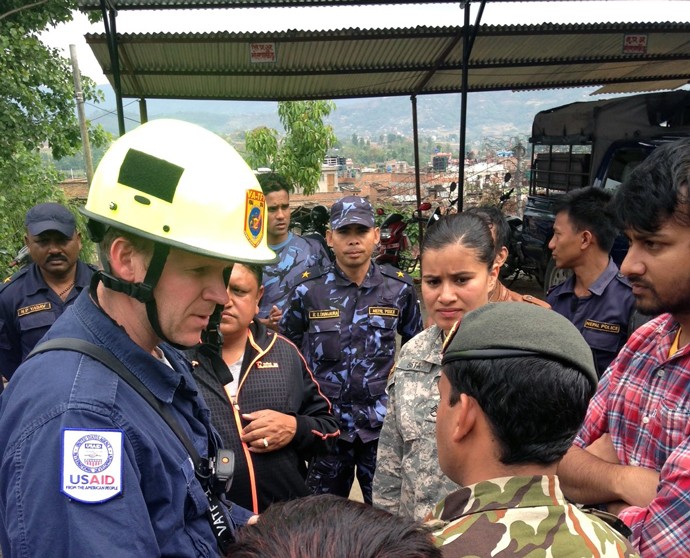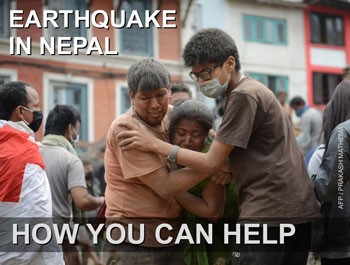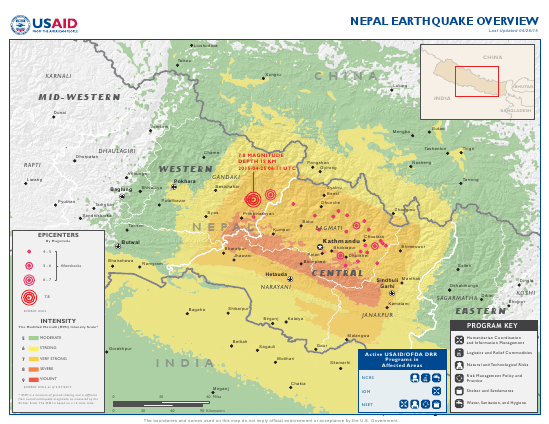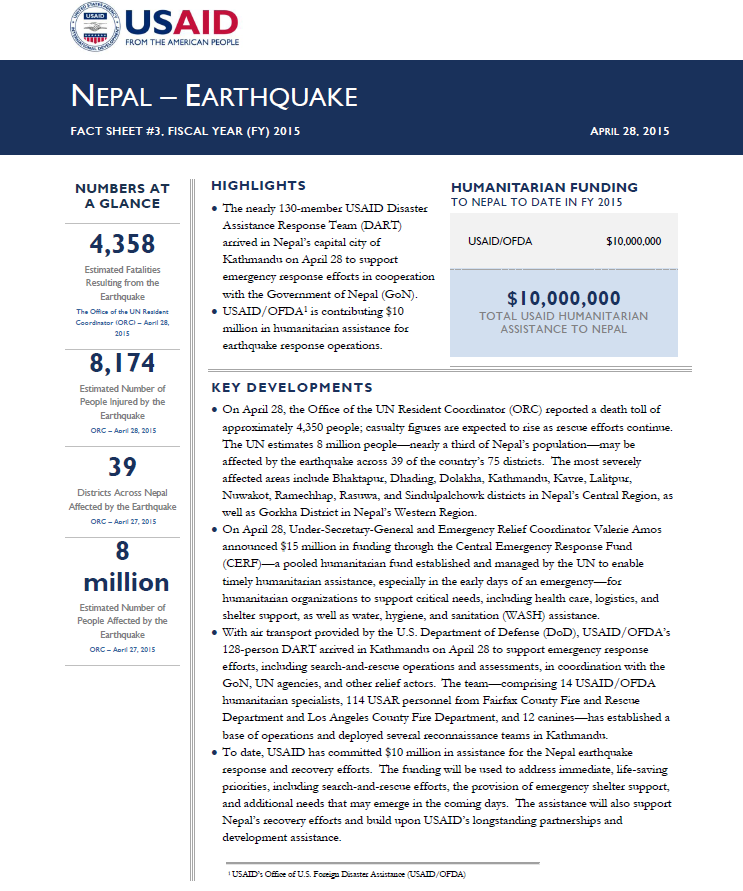April 28, 2015
Highlights
The nearly 130-member USAID Disaster Assistance Response Team (DART) arrived in Nepal’s capital city of Kathmandu on April 28 to support emergency response efforts in cooperation with the Government of Nepal (GoN).
USAID/OFDA is contributing $10 million in humanitarian assistance for earthquake response operations.
Key Developments
On April 28, the Office of the UN Resident Coordinator (ORC) reported a death toll of approximately 4,350 people; casualty figures are expected to rise as rescue efforts continue. The UN estimates 8 million people—nearly a third of Nepal’s population—may be affected by the earthquake across 39 of the country’s 75 districts. The most severely affected areas include Bhaktapur, Dhading, Dolakha, Kathmandu, Kavre, Lalitpur, Nuwakot, Ramechhap, Rasuwa, and Sindulpalchowk districts in Nepal’s Central Region, as well as Gorkha District in Nepal’s Western Region.
Nepal Earthquake Map - April 28, 2015 ![]() (pdf - 1 MB)
(pdf - 1 MB)
Numbers At A Glance
4,358
8,174
39
8 million
Humanitarian Funding:
To Nepal To Date In FY2015:
| USAID/OFDA | $10,000,000 |
| TOTAL | $10,000,000 |
Nepal Earthquake Fact Sheet #3 - 04-28-2015 ![]() (pdf - 251k)
(pdf - 251k)
On April 28, Under-Secretary-General and Emergency Relief Coordinator Valerie Amos announced $15 million in funding through the Central Emergency Response Fund (CERF)—a pooled humanitarian fund established and managed by the UN to enable timely humanitarian assistance, especially in the early days of an emergency—for humanitarian organizations to support critical needs, including health care, logistics, and shelter support, as well as water, hygiene, and sanitation (WASH) assistance.
With air transport provided by the U.S. Department of Defense (DoD), USAID/OFDA’s 128-person DART arrived in Kathmandu on April 28 to support emergency response efforts, including search-and-rescue operations and assessments, in coordination with the GoN, UN agencies, and other relief actors. The team—comprising 14 USAID/OFDA humanitarian specialists, 114 USAR personnel from Fairfax County Fire and Rescue Department and Los Angeles County Fire Department, and 12 canines—has established a base of operations and deployed several reconnaissance teams in Kathmandu.
To date, USAID has committed $10 million in assistance for the Nepal earthquake response and recovery efforts. The funding will be used to address immediate, life-saving priorities, including search-and-rescue efforts, the provision of emergency shelter support, and additional needs that may emerge in the coming days. The assistance will also support Nepal’s recovery efforts and build upon USAID’s longstanding partnerships and development assistance.
USAR AND LOGISTICS
Humanitarian partners report significant damage to buildings and public infrastructure, including collapsed bridges and some blocked roadways due to debris from the earthquake and subsequent landslides.
To support the immediate needs of inaccessible communities, the GoN has also initiated targeted airdrops, comprising emergency food rations, medicine, and plastic sheeting, according to international media sources. The GoN has also mobilized 90,000 troops—approximately 90 percent of the Nepalese Army—to aid response efforts, according to international media sources.
Priority areas for search-and-rescue operations in the Kathmandu Valley include the communities of Sundhara, Gongabu, Patan, and Bhaktapur, according to the GoN-established Multi-National Military Coordination Center (MNMCC). Outside the valley, MNMCC also identified the community of Barpak, located in Gorkha District, as a priority area. As of April 26 local time, international USAR teams were operating in Gongabu and Bhaktapur.
The Logistics Cluster—the coordinating body for humanitarian-based logistics activities, comprising UN agencies, NGOs, and other stakeholders—reports challenges at Tribhuvan International Airport, including limited ground space to accommodate flights, as well as a shortage of air traffic controllers and ground staff. In addition, airport authorities are experiencing difficulty sorting flights and determining which flights to prioritize for landing, causing significant delays in the arrival of assistance. According to the Logistics Cluster, plans are underway to redirect some air traffic to alternative airports via Lucknow, India.
A 24-member UN Disaster Assessment and Coordination (UNDAC) team has arrived in Kathmandu; remaining UNDAC personnel are expected to arrive on April 29. In support of the GoN, UNDAC is coordinating the arrival of international USAR teams through an on-site operations coordination center. Nearly 40 international USAR teams are currently in Nepal. National authorities have indicated that current search-and-rescue capacity on the ground or already airborne as of April 27 is sufficient to cover identified needs, according to the UN Office for the Coordination of Humanitarian Affairs (OCHA). Teams who have not yet deployed have been asked to stand down.
SHELTER

Although assessments remain ongoing, preliminary reports from the GoN indicate that more than 70,000 households may need emergency shelter assistance in disaster-affected districts. Displaced populations are sheltering in 16 locations throughout Bakhtapur, Kathmandu, and Lalitpur districts, including five Armed Police Compounds and 11 open spaces, according to humanitarian agencies. According to satellite imagery analysis released by the UN, displaced communities are also gathering in other spaces, including the Kathmandu’ Halchowk Stadium, Memorial Park located adjacent to Rani Pokhari pond, and several recreational fields.
With previous USAID/OFDA funding, the International Organization for Migration (IOM) has worked with the GoN to identify, prepare, and preserve more than 80 open spaces in Kathmandu Valley, ensuring the sites are available for humanitarian purposes in the event of large-scale disasters such as the April 25 earthquake. As of April 27, the GoN had identified 16 open spaces around Kathmandu to serve as displacement sites for earthquake-affected populations that have lost their homes, according to the ORC.
HEALTH
In Kathmandu Valley, many hospitals are reportedly overcrowded, with medical supplies are nearing depletion.
While GoN Ministry of Health and Population (MoHP) needs assessments are ongoing in 11 of Nepal’s worst-affected districts, preliminary reports indicates that 60–90 percent of health facilities are severely or partially damaged, including hospitals in Dolakha, Nuwakot, and Sindhupalchok districts. In Kathmandu, structural damage to Grande International Hospital—one of Nepal’s largest private hospitals—has rendered it completely inoperable, according to relief actors. The MoHP has set up tents and medical camps to provide medical treatment outside city centers in the worst-affected districts.
Urgent health-related needs include post-earthquake disease outbreak messaging, medical tents, medications, surgical equipment, and post-trauma care and rehabilitation services for people with spinal cord injuries, according to relief agencies. International medical teams and non-governmental organizations (NGOs) are beginning to respond to these needs.
On April 27, the Government of Israel (GoI) announced plans to deploy a 250-member emergency response team, including USAR personnel and medical staff, to support rescue operations and set up a field-based hospital equipped with two operating rooms, intensive care rooms, and 80 hospital beds. An initial seven-member GoI team arrived in Kathmandu on April 26 to begin preliminary needs assessments.
FOOD SECURITY
The Food Security Cluster estimates that approximately 1.4 million people may require food assistance; the total includes 750,000 people residing in rural housing near the epicenter. The earthquake has disrupted preparations for the next planting season, which may affect food security and livelihoods in the coming months. An estimated 70 percent of Nepal’s population relies on agricultural production as primary source of livelihood.
Based on preliminary food security assessments, the UN World Food Program (WFP) plans to provide 1.4 million people with emergency food assistance for three months, with initial rice distributions from WFP’s pre-existing, in-country stockpiles scheduled to commence in Gorkha on April 29.
CONTEXT
On April 25, a magnitude 7.8 earthquake struck central Nepal at a shallow depth of approximately 15 kilometers (km), according to the USGS. The epicenter of the earthquake was located approximately 77 km northwest of Kathmandu, the country’s capital city, and 73 km east of Pokhara, another major city in central Nepal.
The USG immediately issued a disaster declaration for Nepal due to the effects of the earthquake. Within hours of the seismic event, USAID/OFDA had activated a RMT in Washington, D.C., and deployed a DART—including USAR specialists—to support emergency response efforts in Nepal.
For nearly two decades, USAID/OFDA has supported disaster risk reduction (DRR) efforts in Nepal, including throughout Kathmandu Valley. USAID/OFDA funding has enabled the International Organization for Migration (IOM) to identify, prepare, and preserve more than 80 open spaces in Kathmandu Valley to ensure the sites are available for humanitarian purposes—such as distribution centers or warehouses—in the event of large-scale disasters. USAID/OFDA has also supported NRCS to pre-position critical emergency relief supplies in order to address the immediate needs of affected communities following a disaster.
Through the Kathmandu-based National Society for Earthquake Technology (NSET), USAID/OFDA is strengthening Nepal’s earthquake response capacity by institutionalizing DRR at the local and national levels in collaboration with the GoN, non-governmental organizations, schools, and local communities. With USAID/OFDA support, NSET is also promoting public-private partnerships for earthquake risk management and enhancing the capacity of municipal governments to develop and administer building code permits and control systems to better protect against seismic activity.
PUBLIC DONATION INFORMATION
The most effective way people can assist relief efforts is by making cash contributions to humanitarian organizations that are conducting relief operations. A list of humanitarian organizations that are accepting cash donations for disaster responses around the world can be found at www.interaction.org.
USAID encourages cash donations because they allow aid professionals to procure the exact items needed (often in the affected region); reduce the burden on scarce resources (such as transportation routes, staff time, and warehouse space); can be transferred very quickly and without transportation costs; support the economy of the disaster-stricken region; and ensure culturally, dietary, and environmentally appropriate assistance.
More information can be found at:
- The Center for International Disaster Information: www.cidi.org or +1.202.821.1999.
-
Information on relief activities of the humanitarian community can be found at www.reliefweb.int.










Comment
Make a general inquiry or suggest an improvement.